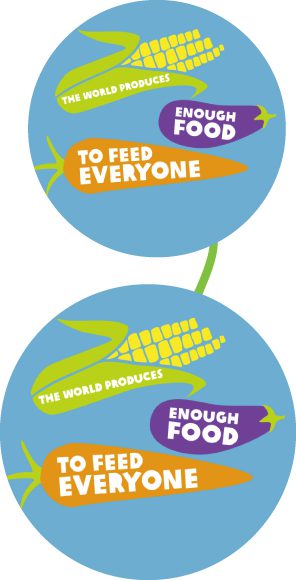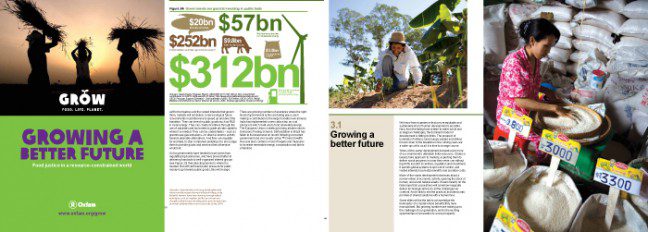Year 9 and 10 Learning Sequence
Another Crack in the wall: The global food system in crisis
1. Shaping Lives
2. Julie’s journey to Timor Leste
3. Please Explain
4. Voicing an opinion
1. Shaping Lives
Australians come from many backgrounds and we have a range of lifestyles and beliefs. We have the freedom to make choices about what we wear and what we say, who we spend time with, what we listen to and read, what we believe in and what we eat. The choices we make about how we live our lives reflect our individuality but there are some requirements that we all share.
What do we need to live? And what is it that makes life worth living? Do we need to be happy and to feel secure?
As a class, brainstorm the things that are most important to your sense of wellbeing.
What are the physical things that you need? What are the things that make you feel good? In many classrooms there will be a range of answers reflecting the fact that we are all different. Yet there are some needs that we all share.
Make a list of the words and phrases from the brainstorm activity on the board.
Work in groups of five or six students to create a tableau, or ‘freeze frame’, of the concept of wellbeing.
Discuss what shape, or body sculpture, you can create to convey a sense that all is well with your lives. Will it be a rounded shape or angular? Will your bodies be curled up or stretched out? Will you be upright or flat on the ground? Will you overlap or be quite separate?
When you have decided on and created your tableau ask someone to take a photo of it.
Now work with the same group and use your bodies to create a second freeze-frame.
This time your tableau should depict life without the things that you identified as being important to your sense of wellbeing.
How will the shape you create be different to the first one? What will it look like? Think of all of the ways that you can use your bodies to convey a message or emotion without using words.
Ask someone to take a photo of your tableau.
Display each group’s photos on the wall or upload them and make a class gallery. How are they different? In what ways are they the same?
In a class discussion, explore the statement: “Difficult lives don’t always look the same.”
2. Julie’s journey to Timor Leste
In early 2014, Masterchef Australia winner Julie Goodwin travelled as an Oxfam Australian ambassador to Timor Leste. One of Australia’s closest neighbours, Timor Leste is located roughly 680km northwest of Darwin, on the eastern half of the island of Timor in South East Asia.
Communities in Timor Leste are are experiencing the effects of climate change first hand, so Julie visited local farmers to learn more about food production and the challenges they are facing.
To record her experience, Julie made a video report and wrote a blog post. Upon her return, she was also interviewed on a Channel Ten morning program.
Read Julie’s blog post about her trip to Timor Leste, and provide written answers to the following questions:
- What is the main message of the blog post?
- What impact did this message have on you?
- How effective do you think that the words of her written report are in conveying the issues facing people in Timor Leste?
- What do you think was the purpose of Julie’s report?
- What tone of language did she use to achieve this purpose? Provide an example from the report.
- This is a personal blog so it is written from Julie Goodwin’s perspective. What features of the piece of communication do you think would have been different if it had been prepared as a news story with the detachment of a professional journalist? How would this have affected the impact of the report for you?
- Why do you think that Oxfam invites high-profile people such as Julie Goodwin to be Oxfam ambassadors?
- Does ‘knowing’ the author of a report influence the way that you read or engage with it? Explain your response.
Now watch Julie Goodwin’s video report
[iframe src=”//www.youtube.com/embed/PrSQY0_hiDs” width=”640″ height=”480″]
In small groups, answer the following questions:
- The video portrays both Julie Goodwin and the people she is visiting. Why do you think that this approach has been taken in the filming? Do you think that the balance between these two ‘subjects’ is effective?
- What is the main message of the video? In what ways is the message different to the written report? Do you think that the video conveys a different message, a different emphasis and/or a different level of understanding?
- Who do you think is the intended audience for this video? What impact would Julie Goodwin, as a celebrity, have on the size and profile of this audience?
- In the ‘Shaping lives’ activity you made a list of the things that we need if we are to achieve a state of wellbeing in our lives. How many of the things you listed in that activity are available to the people in Timor Leste? What words best describe the challenges that these communities face? What qualities would you need to live in Timor Leste?
Share your group’s responses with the rest of the class
Provide a written response to the following activity:
- Imagine that you are visiting Timor Leste and making a video report to convey the impact of climate change on the people who live there. How would your report be different to Goodwin’s?
- Describe the differences with reference to both the content you would include (e.g. setting, tone, point of view, dialogue) and the filming techniques you would use (e.g. framing, angles, sound, focus, movement).
- Present a plan of your report in the form of a storyboard. Create a video as an individual or as a group to bring your storyboard to life!
When Julie arrived back in Australia, she was interviewed on morning TV program, Studio Ten. Watch Julie’s TV interview, and then provide written answers to the following questions:
- During the interview, one of the interviewers states Oxfam’s approach is “teaching a man to fish, instead of giving him a fish”. What does he mean by this? What type of literary device is he using?
- Do you think that the footage shown during the interview was effective in portraying the situation in Timor Leste and the purpose of Julie’s trip? If not, what footage would you have included instead?
- Pretend you were one of the interviewers on the panel. List three more questions you would ask Julie about her experience.
3. Please Explain
The plight of the refugees at Dadaab in Kenya is the result of both natural and man-made phenomena.
The situation in Dadaab is an extreme example of a global food system that isn’t working. There are millions of people across the globe who go to bed hungry each day. Changing patterns of land ownership and food production, differences between consumer behaviour in developed and developing countries, and climate change all contribute to this situation.
Oxfam has produced an animation about the crisis in the global food system.
[iframe src=”//www.youtube.com/embed/3cGEqBrlVzM” width=”640″ height=”480″]
Watch the animation. Discuss the animation as a whole class, focussing on the following questions:
- What is this animation about?
- Who does it portray as the victims and who it portrayed as holding the power?
- What do you believe is the purpose of the animation?
- Who is the intended audience for this animation? What features make you think that this is the target audience?
- Why do you think that animation was selected as the medium for this message? Would a different medium have been more effective? Explain your response.
- What are the main elements that are used in the animation to convey the message? Which of these elements make the most significant contribution?
- Is the style of the graphics used appropriate for the content? Is it suitable for the target audience? Is there a different style that you would have preferred?
- What do you think is the main contribution made by the sound effects? Do you think that the music in the animation complements the message? What music would you have used?
- How would you describe this animation to friends who have not seen it?
Now watch the animation again and provide written responses to the following:
- Do you find the explanation of the global food crisis convincing? Write a summary of the explanation presented in the animation and then identify the points that you agree or disagree with.
- One of the issues raised in the animation is the need to have ethical and sustainable practices for food production, distribution and consumption. Your task is to convey this message in the form of an online poster, video or short animation.
First, decide if you will focus on local actions or whether it will aim at regional, national or global practices. Decide who will be the target audience for your message and think about why you have chosen this audience. This will shape the words and visual elements that you use.
The animation invites you to reflect on how you and your community are impacted by the global food crisis. It also challenges you to identify what you can do to become part of the solution.
Think about your own lifestyle and identify areas where you may be able to reduce waste or consume less energy. Would making these changes affect your wellbeing?
Develop a creative response about what such a challenge means for you by creating a poem, a short story or a digital collage.
4. Voicing an opinion
Oxfam’s GROW campaign aims to share the themes that are explored in the animation you watched in the ‘Please explain’ activity. As part of the GROW campaign three different documents have been developed that explore the same content. Explore each the three texts and identify the distinguishing features of each one.
- What are the main language and design features that each document relies on to convey its message?
- Why do you think that three such different documents would be developed? Define what you think the target audience for each document is.
In this activity you are asked to select which of the three GROW documents you would use to present a persuasive argument in each of the four scenarios presented below. You need to identify the document you would select to support your argument in each scenario and to explain why you selected that document. You do not need to use all of the documents, just the one you identify as most appropriate for each scenario. You may select only specific features of a document for a scenario; if so justify your decision.
Scenario 1: You decide to contribute to a blog on the Oxfam Australia website www.oxfam.org.au . See what others have contributed and use one of the GROW documents to inform your writing.
Scenario 2: You are first speaker for the negative team in a debate on the topic ‘The crisis in the global food system is too big for me to make a difference’.
Scenario 3: You develop a skit to perform for the class that highlights the impact on farmers in developing countries of increased consumerism in countries like Australia.
Scenario 4: You decide to propose that your family buy less processed food and you reduce the amount of food that is wasted in your home. What will be the most effective way of getting the family interested in making the changes? Will you link action at the family level to the global crisis?
After you have completed the activity above, select one of the four scenarios and use the GROW document that you have identified to assist you to prepare the persuasive text indicated in that scenario: your blog contribution, your speech for the debate, your skit or what you will say to your family.




